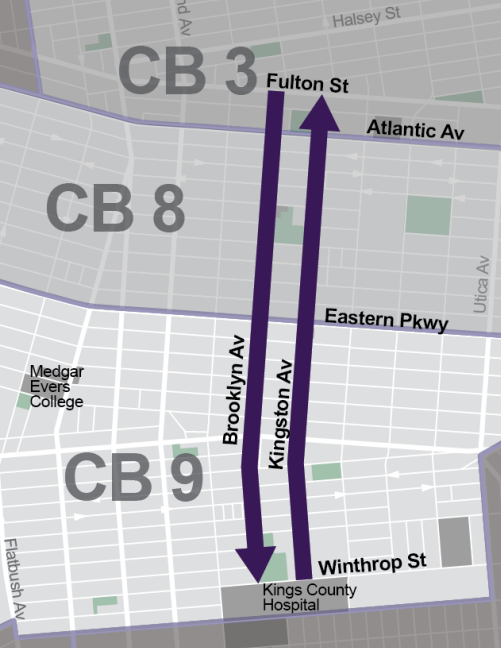Disjointed street design changes coming to Kingston Avenue and Brooklyn Avenue illustrate how DOT's sheepish approach to bike lane implementation interferes with the development of a connected bike network.

At Fulton Street in Bed-Stuy, these north-south routes connect with Tompkins Avenue and Throop Avenue, which both have bike lanes. But for years, the bike lanes didn't extend south of Fulton into Crown Heights and Prospect Lefferts Gardens.
Kingston and Brooklyn, already marked on the city's bike map as "potential future bicycle routes," run through an area with one of the city's higher bike-to-work commute rates. They connect with east-west bike lanes on Eastern Parkway, Empire Boulevard, East New York Avenue, and Maple Street. They are natural candidates for a bike lane extension.
The mile-and-a-half stretch crosses three community boards -- CB 3 in Bed-Stuy, CB 8 in Crown Heights, and CB 9 south of Eastern Parkway. Instead of bringing a cohesive project to all three boards, DOT proposed three different designs, one for each community board.
Community Board 9 has a mixed record on bike lanes -- its members pushed DOT to add them to an Empire Boulevard road diet in 2009, yet weren't able to muster enough votes last year to support a road diet with bike lanes on Franklin Avenue.
On both Kingston and Brooklyn, DOT proposed keeping two motor vehicle lanes on the southernmost blocks near Kings County Hospital and going down to one lane north of Lefferts Avenue. Though there is plenty of room for bike lanes in CB 9, the plan doesn't include them. Instead, parking lanes on both sides of the street would be enlarged to up to 13 feet wide [PDF].
Why didn't DOT propose extending the bike lanes south into CB 9? I asked DOT Deputy Commissioner Ryan Russo after a press conference this morning. "There’s differences in widths and traffic flow, and those sorts of things," he said.
Later, he cited rapid neighborhood change as a factor. "Have you read any coverage of CB 9? They are literally disintegrating because of gentrification. Literally disintegrating," Russo said, referring to rancor over a rezoning study for Empire Boulevard.
Trouble is, ditching the bike lanes didn't help DOT get CB 9's support. Although its transportation committee backed the proposal in June [PDF], the full board voted it down later that month, DOT says.
Things look different in CB 8, where DOT proposed a road diet including bike lanes between Eastern Parkway and Atlantic Avenue [PDF]. Thanks in large part to transportation committee co-chairs Rob Witherwax and Dr. Fred Monderson, the board backed a similar design for Franklin Avenue last year. In April, CB 8 supported the bike lanes for Kingston and Brooklyn, with 33 in favor and two opposed [PDF]. DOT says the markings have been installed, with signal retiming coming next.
The shortest section of the project is in Community Board 3, between Atlantic Avenue and Fulton Street. DOT proposed sharrows connecting the Tompkins/Throop and Brooklyn/Kingston bike lane pairs, a treatment Russo pointed out is common for a "wiggle" route connecting otherwise disjointed bike lane segments. The plan would not have removed any traffic lanes or altered street design, other than adding stencils showing where cyclists should ride [PDF].
CB 3 is often hostile to street safety projects, including Slow Zones and curb extensions, and in June the board voted against the sharrows, with 16 against and 11 in favor, according to DNAinfo. DOT told Streetsblog that it is "still in discussions with local stakeholders about the project."
This post's second paragraph has been updated to reflect the recent implementation of bike lanes in Community Board 8.





